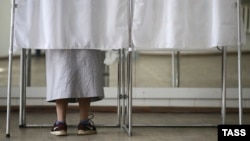Russia has never held a post-Soviet election that met recognized democratic standards. But that does not mean that the fraud has been evenly spread across the country.
In a blog post on September 17, Grigory Melkonyants, the co-chairman of the independent Golos election-monitoring organization that has been attacked by the government as a supposed "foreign agent" NGO, presented a grouping of all Russia's regions -- plus Ukraine's Sevastopol and the region of Crimea that Moscow annexed in 2014 -- according to an analysis of the level of fraud detected in the 2016 Duma elections, the 2018 presidential election, and the 2020 national plebiscite on a package of hundreds of constitutional amendments.
The ranking was assembled by statistician Sergei Shpilkin, who uses statistical analysis to estimate the percentage of "excess votes" in each voting precinct. His analysis of the 2016 elections found that the ruling United Russia party was given about 30 more seats than it likely earned in the party-list voting because of fraud.
Shpilkin put all Russia's regions into six groups from "clean" to "a rich tradition of fake voting protocols." Nine regions made the latter group, most of them from the North Caucasus, but also joined by Tyva, Kemerovo Oblast, and the Yamalo-Nenets Autonomous Region. In the 2016 elections, those regions accounted for 11 percent of the vote.
Twelve regions were placed in Group 5, regions with "a rich tradition of falsification," and accounted for 21.3 percent of the vote in 2016.
Eighteen regions made Group 4, regions with "a large risk of falsification." This group included St. Petersburg, Leningrad Oblast, Moscow Oblast, and most of the regions of southwestern Russia. They accounted for 25.1 percent of the vote in 2016.
Group 3, regions with "some risk of falsification," included 16 regions, mostly in European Russia. The annexed Ukrainian Black Sea region of Crimea made this group. Group 3 regions accounted for 13.5 percent of the 2016 vote.
Twenty-one regions made Group 2, regions that are "relatively clean." This group included Moscow, the annexed Ukrainian city of Sevastopol, and a mix of European and Siberian regions. They contributed 18.9 percent of the vote in 2016.
Finally, nine regions were placed in Group 1, the "clean" group. They included Karelia, the Perm region, the Khabarovsk region, Arkhangelsk Oblast, Irkutsk Oblast, Murmansk Oblast, Sverdlovsk Oblast, Tomsk Oblast, and Chelyabinsk Oblast. These regions accounted for 10.2 percent of the vote in 2016.
In all, in 2016, the 39 regions in the four groups most inclined to election fraud accounted for about 70 percent of the vote in 2016.










